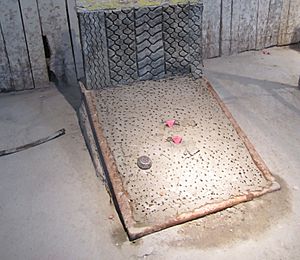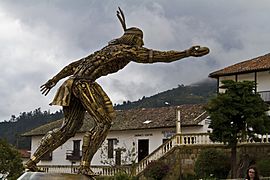Tejo (sport) facts for kids

Target post of a tejo field
|
|
| Nicknames | Tejo, turmequé |
|---|---|
| First played | Pre-Columbian |
| Characteristics | |
| Contact | No |
| Team members | individual, up to 6 |
| Mixed-sex | Yes |
| Venue | Tejo field |
| Presence | |
| Country or region | Colombia |
| Olympic | No |
| Paralympic | No |
Tejo (pronounced "TAY-ho") is a super fun and traditional throwing sport from Colombia. It's also sometimes called turmequé. What makes Tejo really exciting is that you throw a metal disc at targets that have a little bit of gunpowder. When you hit the target just right, it makes a loud "BOOM!" sound!
Contents
The History of Tejo
The exact beginning of Tejo is a bit of a mystery. There are many stories, but it's hard to know which ones are completely true.
However, most people agree that this sport started with the native people of central Colombia. They might have played a game very similar to Tejo more than 500 years ago! Some stories say they used a special golden disc called zepguagoscua.
Tejo's Place in Culture
Tejo is a very popular game in Colombia, especially among everyday people. While there are fancy Tejo places, many are simple and used by everyone. People see Tejo as a link to their ancient pre-Columbian history. Only soccer is more popular in Colombia than Tejo.
Even though Tejo started in Colombia, you can find professional teams in nearby countries too. These include Venezuela, Ecuador, and Panama. But it's most popular and developed in its home country, Colombia.
How to Play Tejo
Tejo can be played just for fun with friends or in big, serious championship tournaments.
The game involves throwing a heavy metal disc, which is also called a "tejo." You throw it across a playing area that's about 18.5 meters (about 60 feet) long. Your target is a special board covered with clay. This board is set up at a 45-degree angle.
There are two of these clay boards, one at each end of the field. The board has a wooden frame that holds the clay. It also has a protective barrier to stop the tejo from flying off. Inside the clay, there's a strong metal pipe or ring. This pipe is the main target you want to hit!
You must throw the tejo from a special throwing area. The main goal is to hit the metal target inside the clay board at the other end. The most exciting part of Tejo is hitting the small, triangle-shaped targets called "mechas." These "mechas" contain gunpowder and are placed around the metal pipe. When your tejo hits a "mecha," it explodes with a loud bang, like a small firecracker!
Scoring Points
While scoring can sometimes change, here's how points are usually given in Tejo:
- Hand: You get 1 point if your tejo is the closest to the target at the end of a round.
- Hit: You get 3 points for every "mecha" you explode. Boom!
- Bulls-eye: You get 6 points if your tejo lands right inside the metal target.
- Strike: This is the best! You get 9 points if your tejo hits a "mecha" AND lands inside the target in the same throw.
The Tejo Pitch
The "pitch" or "post" is the special target area. It's usually a wooden box, about 90 cm (35 inches) wide and 1 meter (40 inches) long. This box is filled with clay and tilted at an angle, usually between 35 and 45 degrees. The type of clay can vary, from regular mud to special modeling clay.
When the tejo lands, it sticks into the clay. Depending on how soft or firm the clay is, it can be easy or a little hard to dig out your tejo. So, the clay's consistency is quite important!
The protective board around the pitch helps keep the tejo from flying out of the playing area if you miss the target. Its size isn't fixed, but it's always bigger than the clay box itself.
The metal target inside the clay is usually a strong metal pipe. It's set up so it won't move easily when hit by a fast-moving tejo. Often, it's welded or screwed firmly to the wooden frame. Because Tejo is a traditional sport, there aren't strict rules for how every pitch must be built.
Tejo Today
In Colombia, you can find professional Tejo teams in many big cities and smaller towns. Some teams even have sponsors from local companies or people who really love the sport.
Today, Tejo competitions are well-organized tournaments. The most common type is called "torneos Relampago," which means "lightning tournaments." These are usually played over just one weekend, with teams getting eliminated quickly. Winners can get trophies, medals, and even money! Sometimes, household items are given as prizes too.
Tejo isn't usually shown on big TV channels, except during the National Games of Colombia. But many people go to watch the tournaments, which makes it popular for brands that want to connect with a wide audience.
Tejo has also become a cool activity for travelers exploring Colombia. Many hostels around the country even host free Tejo nights for their guests!
There's also a newer version of Tejo. In this version, the clay, plasticine, and gunpowder "mechas" are removed. Instead, electronic sensors are used to detect when the target is hit.
See also
 In Spanish: Tejo (deporte) para niños
In Spanish: Tejo (deporte) para niños






